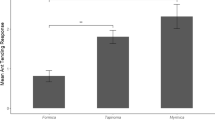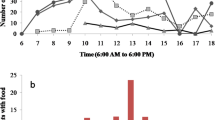Summary
A model of individual foraging in social insects as presented that formalises the dynamics of foraging and concentrates on the collective rather than the individual benefit, quantifying the relationships between a colony's foraging area, number of foragers and foraging energy budget and the food sources' rate of arrival, disappearance and capture. A series of experiments, in which a number of prey were offered to colonies of the individually foraging antPachycondyla (ex-Neoponera) apicalis confirm the hypotheses implicit in the model and measured the rates of capture and competition. 60 days observation of 3P. apicalis colonies' foraging activity are summarised and used in conjunction with the model to obtain estimations of the density and rate of arrival of available prey in the foraging area. We examine how a colony's foraging benefit may be influenced by its foraging area, the number of foragers, and the forager/non-forager ratio and show that a colony's jocial structure strongly limits its potential foraging benefit. Within these limits,P. apicalis does not appear to be an optimal forager.
Similar content being viewed by others
References
Abraham M, Pasteels JM (1980) Social behaviour during nestmoving in the antMyrmica rubra L. (Hym. Form.). Ins Soc 27:127–147
Baroni-Urbani C, Josens G, Peakin GJ (1978) Empirical data and demographic parameters of host-finding by insect parasites. In: Brian MV (ed) Production Ecology of Ants and Termites. Cambridge University Press, Cambridge, pp 5–44
Curio E (1976) The Ethology of Predation. Springer Verlag, Berlin
Deneubourg JL, Goss S, Pasteels JM, Fresneau D, Lachaud JP (1987) Self-organization mechanisms in ant societies (II): Learning in foraging and division of labor. In: Pasteels JM, Deneubourg JL (eds) From Individual to Collective Behaviour in Social Insects. Birkhäuser Verlag, Basel Boston, pp 177–196
Deneubourg JL, Goss S, Jaffé K (1989) How to obtain an optimal balance between scouts and recruits in social insects. Proc Coll Soc Ins (in press)
Cachaud JP, Fresneau D (1987) Social regulation in ponerine ants. In: Pasteels JM, Deneubourg JL (eds) From Individual to Collective Behaviour in Social Insects. Birkhäuser, Basel Boston, pp 197–219
Goss S, Deneubourg JL, Pasteels JM, Josens G (1989) A model of non-cooperative foraging in social insects. Am Nat (in press)
Harkness RD, Maroudas NG (1985) Anim Behav 33:916–928
Hassell MP (1978) The Dynamics of Arthropod Predator-Prey Systems. Princeton University Press, Princeton, New Jersey
Holling CS (1966) Mem Entomol Soc Canada 48:1–86
Jensen TF, Holme-Jensen I (1980) Energetic cost of running in workers of three ant species,Formica fusca L.,Formica rufa L, andCamponotus herculeanus L. (Hymenoptera Formicidae). J Comp Physiol 137:151–156
Johnson LK, Hubbel SP, Feener DH Jr (1987) Defense of food supply eusocial colonies. Am Zool 27:347–358
Lachaud JP, Fresneau D, Garcia-Perez J (1984) Etude des stratégies d'approvisionnement chez 3 espèces de fourmis ponerines (Hymenoptera, formicidae). Folia Entomol Mex 61:159–177
Laing J (1938) Host finding by insect parasites. II. The chance ofTrichogramma evanescens finding its host. J Exp Biol 15:281–302
Lighton J, Bartholomew G, Feener Jr D (1987) Energetics of locomotion and load carriage and a model of the energy cost of foraging in the leaf-cutting andAtta Columbica Guer. Physiol Zool 60:524–537
Mackey AP (1978) Growth and bioenergetics of the mothCyclophragma lencostricta. Oecologia 32:367–376
May RM (1973) Stability and Complexity in Model Ecosystems. Princeton University Press, Princeton, New Jersey
Nielsen MG (1972) An attempt to estimate energy flow through a population of workers ofLasius alienus (Forst) (Hymenoptera Formicidae). Natura Jutlandica 16:97–107
Orians GH, Pearson NE (1979) On the theory of central place foraging. In: Horn DJ, Stairs GR, Mitchell RD (eds) Analysis of Ecological Systems. Columbus, Ohio State University Press, pp 155–177
Oster GF, Wilson EO (1978) Caste and Ecology in the Social Insects. Princeton University Press, Princeton, New Jersey
Passera L (1984) L'Organisation Sociale des Fourmis. Privat, Toulouse
Peakin GJ (1972) Aspects of productivity inTetramorium caespitum L. Ethologica Polska 20:6, 55–62
Petrusewicz K, Macfayden A (1970) Productivity of Terrestrial Animals: Principals and Methods (IBP Handbook No 13). Blackwell Scientific Publications, Oxford Edinburgh
Randolph PA, Randolph GC, Barlow CA (1975) Age specific energetics of the pea aphidAcyrtosiphon pisum. Ecology 56:319–327
Schmid-Hempel P, Kacelnik A, Houston A (1985) Honeybees maximise efficiency by not filling their crop. Behaw Ecol Sociobiol 17:61–66
Wehner R, Harkness R, Schmid-Hempel P (1983) Foraging Strategies in Individually Searching AntsCataglyphis bicolor (Hym. Formicidae). Gustav Fischer Verlag, Stuttgart New York
Author information
Authors and Affiliations
Rights and permissions
About this article
Cite this article
Goss, S., Fresneau, D., Deneubourg, J.L. et al. Individual foraging in the antPachycondyla apicalis . Oecologia 80, 65–69 (1989). https://doi.org/10.1007/BF00789933
Received:
Published:
Issue Date:
DOI: https://doi.org/10.1007/BF00789933




